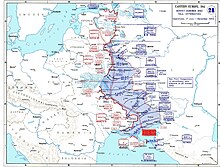| The Kuban Bridgehead | |||||||
|---|---|---|---|---|---|---|---|
| Part of the Battle of the Caucasus on the Eastern Front of World War II | |||||||
 Map of July–December 1943 positions of the Eastern Front. The Kuban Bridgehead starts by Novorossiysk | |||||||
| |||||||
| Belligerents | |||||||
|
|
| ||||||
The Kuban Bridgehead (German: Kuban-Brückenkopf), also known as the "Goth's head position" (Gotenkopfstellung),[3] was a German military position on the Taman Peninsula, Russia, between the Sea of Azov and the Black Sea. Existing from January to October 1943, the bridgehead formed after the Germans were pushed out of the Caucasus. The heavily fortified position was intended as a staging area for the Wehrmacht which was to be used to renew attacks towards the oil wells of the Caucasus. Axis positions in the bridgehead were repeatedly subjected to large Soviet offensives, but none ever comprehensively broke the Axis defensive lines. The bridgehead was abandoned when the Red Army breached the Panther–Wotan line, forcing an evacuation of the German forces across the Kerch Strait to Crimea.
- ^ a b Encyclopedia of World War II: A Political, Social, and Military History. Oxford, England: ABC-CLIO. 2005. p. 307. ISBN 1-57607-999-6.
- ^ a b Tessin, G., Verbänd und Truppen der deutschen Wehrmacht und Waffen - SS im Zweiten Weltkrieg 1939-1945, Biblo Verlag, Osnabruck, 1977. taken from http://www.cgsc.edu/CARL/nafziger/939GXXP.PDF Archived 2016-03-04 at the Wayback Machine pg 10
- ^ Weinberg, Gerhard L. (2005). A World at Arms: A Global History of World War II Second Edition. New York, NY: Cambridge University Press. p. 456. ISBN 978-0-521-61826-7.